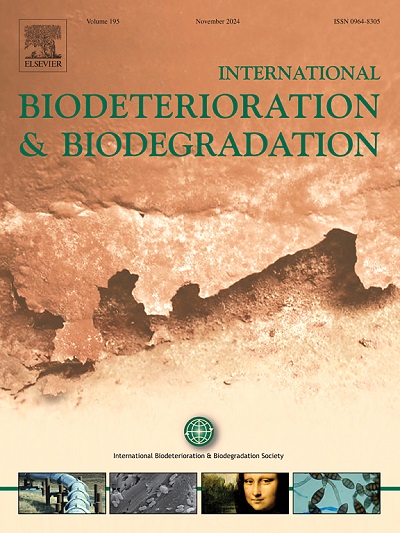Black stains of Lascaux Cave involve different melanin synthesis pathways as shown by Alkaline/H2O2 hydrolysis and UHPLC-ESI/QTOF analysis of pigmented fungal isolates and stains from cave walls
IF 4.1
2区 环境科学与生态学
Q2 BIOTECHNOLOGY & APPLIED MICROBIOLOGY
International Biodeterioration & Biodegradation
Pub Date : 2025-06-13
DOI:10.1016/j.ibiod.2025.106142
引用次数: 0
Abstract
Lascaux cave in southwestern France is a UNESCO landmark famous for its Paleolithic engravings and paintings, but it suffered from microbial outgrowth and black strain formation following unbalanced touristic operations and chemical treatments. Pigments synthesized by black fungi isolated from these stains were previously identified as melanin, but a limited range of black fungi was assessed and black stains themselves have been investigated by surface-enhanced Raman spectroscopy, only. This study aimed at identifying the origins and chemical features of the melanin polymers produced by 10 black fungal strains isolated from Lascaux black stains. Fungi were identified by ITS2 sequencing. Mycelial pigment extracts were analyzed by UHPLC/ESI-QTOF after alkaline H2O2 hydrolysis, which allowed to detect simultaneously monomers of different melanin types. Analytical markers from several biosynthetic pathways of melanin were evidenced in all fungal isolates, and some strains showed the ability to produce melanin from at least five different pathways, which to our knowledge constitutes the first report of such a variety of means to achieve black pigmentation within a single fungal strain. As proof of principle, this method was applied to black stains directly collected from the cave and revealed three to four melanin types in samples from the Apse, the Nave and the Passage. Some of these melanin types corresponded to those of the fungal isolates analyzed, namely Alternaria alternata, Acremonium nepalense or Ochroconis lascauxensis. This is the first characterization of the types of melanin synthesized on Lascaux surfaces. Results emphasize the interest of this method to understand different pigmentation patterns in caves and to analyze melanin pigments from diverse biological matrices.
通过碱性/H2O2水解和UHPLC-ESI/QTOF分析,发现拉斯科洞壁黑色斑点涉及不同的黑色素合成途径
法国西南部的拉斯科洞穴是联合国教科文组织的地标,以旧石器时代的雕刻和绘画而闻名,但由于不平衡的旅游活动和化学处理,它遭受了微生物的繁殖和黑色菌株的形成。从这些染色剂中分离出的黑色真菌合成的色素以前被鉴定为黑色素,但仅对有限范围的黑色真菌进行了评估,而黑色染色剂本身也仅通过表面增强拉曼光谱进行了研究。本研究旨在鉴定从拉斯科黑染中分离的10株黑真菌产生的黑色素聚合物的来源和化学特征。真菌通过ITS2测序鉴定。菌丝色素提取液经碱性H2O2水解后,采用UHPLC/ESI-QTOF分析,可同时检测不同类型黑色素单体。在所有真菌分离株中都证实了几种黑色素生物合成途径的分析标记,并且一些菌株显示出至少从五种不同途径产生黑色素的能力,据我们所知,这是首次报道在单一真菌菌株中通过多种手段实现黑色色素沉着。作为原理证明,将这种方法应用于直接从洞穴中收集的黑色污渍,并在后殿,中殿和通道的样本中发现了三到四种黑色素类型。其中一些黑色素类型与所分析的真菌分离株相对应,即Alternaria alternata, Acremonium nepalense或Ochroconis lascauxensis。这是第一次表征在拉斯科表面合成的黑色素类型。结果强调了该方法对了解洞穴中不同的色素沉着模式和分析来自不同生物基质的黑色素色素的兴趣。
本文章由计算机程序翻译,如有差异,请以英文原文为准。
求助全文
约1分钟内获得全文
求助全文
来源期刊
CiteScore
9.60
自引率
10.40%
发文量
107
审稿时长
21 days
期刊介绍:
International Biodeterioration and Biodegradation publishes original research papers and reviews on the biological causes of deterioration or degradation.

 求助内容:
求助内容: 应助结果提醒方式:
应助结果提醒方式:


